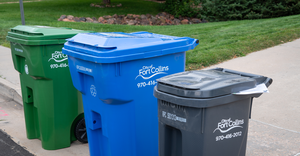EPR and Other Emerging Policies and Laws to Spur Composting
In this Q&A, Rhodes Yepsen, executive director of the Biodegradable Products Institute (BPI) World and Alex Truelove, BPI’s legislation and advocacy manager, jointly provide insight to catch us up on evolving composting regulations.

About nine U.S. states have enacted laws around composting in the past decade, from rules around compostable product labeling and specifications to extended producer responsibility (EPR) programs that include these processing methods, leveraged to divert food and food packaging from landfills, reduce methane emissions and enhance soil and plant health.
In this Q&A, Rhodes Yepsen, executive director of the Biodegradable Products Institute (BPI) World and Alex Truelove, BPI’s legislation and advocacy manager, jointly provide insight to catch us up on evolving composting regulations.
Waste360: What does having BPI certification really tell about a product or packaging?
BPI: The Biodegradable Products Institute (BPI) certifies compostable products and packaging to rigorous standards and signifies a commitment to environmental stewardship and responsible waste management practices.
Product testing for BPI certification involves comprehensive assessments to ensure compliance with ASTM standards for compostability, plus criteria in our certification scheme. These tests evaluate factors such as disintegration, biodegradation, and absence of harmful substances.
As states continue to regulate packaging and terminology around compostability, BPI's certification helps companies demonstrate that products and materials are compliant with these definitions.
Moreover, BPI's certification supports waste diversion and environmental protection goals set by businesses and governments, making it clear which products have met rigorous compostability criteria and are suitable for being collected with food scraps for composting.
Waste360: What states have done the best policy work?
BPI: Several states have shown progress in implementing policies related to compost infrastructure and compostable products. Washington is one key example.
The state has implemented programs to support compost infrastructure development and has regulations in place to encourage composting. Additionally, Washington has requirements for compostable product labeling and specifications, ensuring that consumers can easily identify and properly dispose of compostable items.
From new extended producer responsibility (EPR) programs in California and Colorado that include composting, to compostable grocery produce bag requirements in California, to on-product labeling laws in half a dozen states, there is a flurry of activity as it pertains to compost policy work. Most states are in their infancy of these initiatives; there is continual improvement rolling out [including in] enforcing these policies.
Waste360: How do you see EPR programs for packaging impacting composting infrastructure?
BPI: EPR programs for packaging can significantly contribute to improving composting infrastructure by providing financial resources through fees paid by compostable product-makers. These funds can be allocated towards the costs of receiving and processing compostable packaging, including the development and maintenance of composting facilities, as well as educational initiatives to promote proper composting practices. By supporting well-conceived EPR laws that specifically include composting, organizations like BPI and The US Composting Council (USCC) can facilitate the expansion and enhancement of composting infrastructure, ultimately fostering widespread access so that more households and businesses have the opportunity to compost alongside recycling.
Waste360: What are some pending changes for packaging?
BPI: Washington and Colorado are enforcing new labeling requirements in July aimed at standardizing consumer information. These requirements include adherence to ASTM standard specifications that outline the necessary tests and pass/fail criteria and require third-party certification to ensure compliance. Additionally, they prohibit misleading terminology like "biodegradable," "oxo-degradable," and "decomposable" to prevent confusion among consumers.
New wrinkles (elements of confusion or inconsistency) include visual requirements, including the use of specific text ("compostable"), symbols, and colors, though they vary by state. Washington mandates the use of green, brown, or beige colors in specific applications, while Colorado permits green only but with more flexible application methods, including symbols like certification logos.
In addition to labeling, recent changes include a petition to the US Department of Agriculture’s (USDA) National Organic Program to update the definition of compost to include compostable products as a feedstock. This petition seeks to address issues raised in the California regulations that would prohibit a product from being marketed and sold as compostable by 2026 if it does not become allowed in compost approved for use in organic agriculture.
Waste360: Can you tell us more about Colorado and California’s amendments around composting and EPR? What’s the ultimate goal?
BPI: BPI advocated for changes to align with our principles co-developed with USCC, particularly around funding and representation. Our goal was to offer insights into policy development, industry standards, and best practices to support the integration of compostable products into waste management systems.
BPI worked collaboratively to mobilize stakeholders and legislators in California and Colorado to advocate that composters and compostable products would be supported alongside recyclable and reusable products, following the guidelines we developed with USCC.
Waste360: What did you learn through the work in Colorado and California to inform similar work elsewhere?
BPI: We learned that it takes lots of work just to have stakeholders understand the importance of including compost in EPR, and the fundamental differences with recycling. EPR laws designed to improve outcomes for products have historically tended to focus on recycling, since that’s the majority, and haven’t included funding to composters, either to address contamination or help composting infrastructure; therefore, compostable product-makers have paid into systems that effectively siphon their contributions to other waste activities. Advocates and bill drafters don’t always understand those negative consequences, or the nuances of compost systems.
Waste360: What similar work is BPI or others doing to advance similar policies in other states?
BPI: BPI is actively working to encourage other states to adopt EPR that adequately addresses compost and compostable products. This includes collaborating with states that have introduced EPR legislation or conducted needs assessments, such as Connecticut, Illinois, Massachusetts, Maryland, Minnesota, New York, New Hampshire, Pennsylvania, Tennessee, and Washington. BPI provides written comments and suggested amendments, testifies, and works with stakeholders throughout the legislative process.
Additionally, we host legislation and advocacy committee calls dedicated to collecting input, discussing issues, and identifying how best to advocate for compostables within zero waste systems to support the growth of the broader composting industry.
Waste360: Who are all the players that need to come together to decide what needs to go into composting laws?
BPI: The players that need to come together include government entities, composters, environmental non-governmental organizations (ENGOs), product manufacturers, brands, retailers, and consumers.
Each of these stakeholders brings unique perspectives and expertise. Government entities are responsible for creating and enforcing regulations, and at the municipal level for educating consumers on what can be collected, while composters are involved in the actual processing of the materials. ENGOs advocate for environmental causes and can provide valuable insights into the environmental benefits of composting. Product manufacturers, brands, and retailers influence the design, production, and distribution of compostable products. Consumers, as end-users, can drive demand for sustainable practices and materials.
About the Author
You May Also Like




